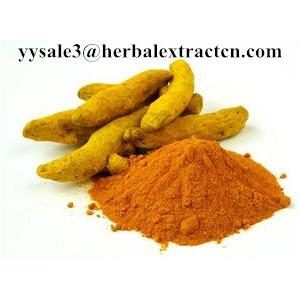
Add to Cart
Product Name: Curcumin
Botanical Source: Curcuma longa L.
Part Used: Root
Appearance: Orange yellow powder
CAS NO.:458-37-7
Molecular formula: C21H20O6
Molecular weight:368.38
Test method: HPLC
Specification: 95%
Active Ingredients:Curcumin
Place of origin:China
Description: Curcumin is a diarylheptanoid. It is the principal curcuminoid of turmeric, which is a member of the ginger family (Zingiberaceae).It can be used as a food coloring.As a food additive, its E Number is E100.
Main function
1.Natural color pigment. For the color of sausage products, canned food and halogen products, etc.
2.Oxidation and Anti-Oxidation.It protect cells against damage caused by free radicals;
3. Curcumin has effects on the cardiovascular system.
3.Help in preventing hair loss, especially male pattern baldness;
4.Improving blood circulation, lowering blood pressure and treating amenorrhea and protecting the liver;
5.Lipid-lowering effect.Curcumin reduced plasma total cholesterol, β- lipoprotein,
triglycerides and liver cholesterol, lipoprotein correct α- and β- imbalance role, but had no effect on endogenous cholesterol. Studies have shown that curcumin can inhibit
the synthesis of fatty acids.
6.Choleretic effect.Curcumin has a choleretic effect, can increase the production and
secretion of bile and promote cholecystokinin, and to the role of curcumin is strongest.
7.Anti-inflammatory effects.
Packaging
-Packed in paper-drum with two plastic-bags inside.
-25kg/drum or according to the demands of customers.
Storage:Store at cool&dry place.Protect from light,moisture and pest infestation.
Shelf life:2 years when properly stored.
Product Name: Marigold P.E, Lutein
Latin Name: Tagetes erecta L.
Part Used: Flower
Main content: Lutein 2% 20%
CAS NO.: 127-40-2
molecular formula:C40H56O2
Molecular weight: 568.85
Appearance: Orange-red
Place of origin: China
Description: Lutein (from Latin luteus meaning "yellow") is a xanthophyll and one of 600 known naturally occurring carotenoids. Lutein is synthesized only by plants and like other xanthophylls is found in high quantities in green leafyvegetables such as spinach, kale and yellow carrots. Lutein is obtained by animals directly or indirectly, from plants. Lutein is apparently[citation needed] employed by animals as an antioxidant and for blue light absorption. Lutein is found in egg yolks and animal fats. In addition to coloring yolks, lutein causes the yellow color of chicken skin and fat, and is used in chicken feed for this purpose. This xanthophyll, like its sister compound zeaxanthin, has primarily been used as a natural colorant due to its Orange-red color. Lutein absorbs blue light and therefore appears yellow at low concentrations and orange-red at high concentrations. Lutein isalso anti-angiogenic. It inhibits vascular endothelial growth factor(VEGF). Today the coloring of the egg yolk has become the primary reason for feed fortification.Lutein is not used as a colorant in other foods due to its limited stability, especially in the presence of other dyes.
Main function
1.Lutein was traditionally used in chicken feed to improve the color of broiler chicken skin. Polled consumers viewed yellow chicken skin more favorably than white chicken skin. Such lutein fortification also results in a darker yellow egg yolk.
4. Natural lutein is an excellent antioxidant, which can resist free radicals in human body and organ damage, which can prevent the aging of the body, such as cardiovascular disease, coronary heart disease and cancer. One of theunique function of lutein is the prevention of blindness and vision loss due to age - related macular degeneration.
Application
1.Applied in feedingstuff.
2.Applied in pharmaceutical stuff.
3.Applied in cosmetic field.
Storage: Store at cool&dry place.Protect from light,moisture and pest infestation.
Shelf life: 2 years when properly stored.
| Item | Specification | Method |
| Drying Method | Spray Drying | |
| Physical Charactristics | ||
| Partical Size | NLT100%Through 80 mesh | GB 5507-2008 |
| Loss on Drying | ≤5% | GB 5009.3-2010 |
| Ash | ≤5% | GB 5009.4-2010 |
| Bulk Density | 50-60g/100ml | |
| Pesticide Residue | ||
| 666 | <0.2ppm | GB/T5009.19-2008 |
| DDT | <0.2ppm | GB/T5009.19-2008 |
| Heavy metals | ||
| Total Heavy Metals | ≤10ppm | CP2010 |
| Arsenic | ≤1ppm | CP2010 |
| Lead | ≤1ppm | CP2010 |
| Mercury | ≤1ppm | CP2010 |
| Microbiological Tests | ||
| Total Plate Count | ≤1000cfu/g | GB 4789.2-2010 |
| Total Yeast & Mold | ≤100cfu/g | GB 4789.15-2010 |
| E.Coli | Negative | GB 4789.3-2010 |
| Salmonelia | Negative | GB 4789.4-2010 |
| Staphylococcus | Negative | GB 4789.10-2010 |
| Hot Products |
| Astragalus Extract |
| Althaea Officinalis Root Extract |
| Aloe-emodine |
| Buckwheat extract |
| Chinese Ivy Stem Extract |
| Cistanche Deserticola Extract |
| Cassia Seed Extract |
| Cactus Plant Extract |
| Cordyceps Sinensis Extract |
| Cytisine |
| Dandelion Extract |
| Fenugreek Seed P.E. |
| Ginger Extract |
| Gojiberry Extract |
| Grape Seeds Extract |
| Harmine |
| Hawthorn Extract |
| Kudzu Root P.E. |
| Licorice Extract |
| Lilium Powder |
| Lycopene |
| Mint Extract |
| Panax ginseng Extract |
| Phyllanthus emblica Extract |
| Poriacocos Extract (India Bread P.E.) |
| Reishi Mushroom Extract |
| Radix isatidis P.E. |
| Rhodiola Rosea Extract |
| Schisandra P.E. |
| Salvia miltiorrhiza Extract |
| Sclareolide |
| Swertiamarin |
| Oriental Raisin Tree Extract |
| White kidney bean P.E. |






for more: http://www.herbalextractscn.com